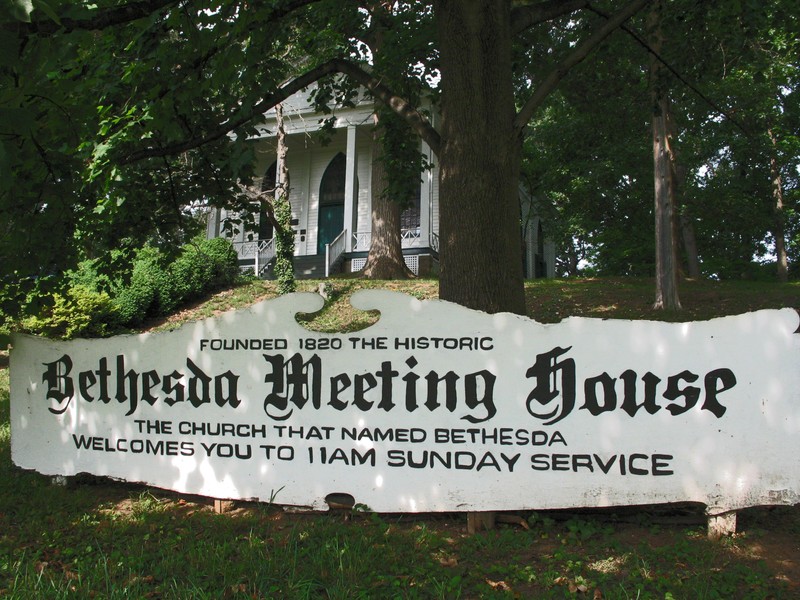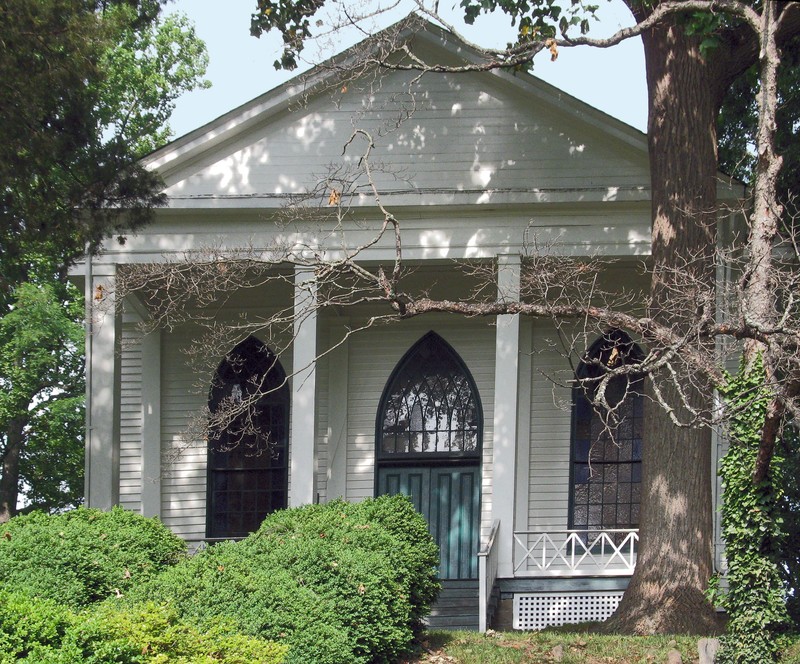Bethesda Meeting House
Introduction
Text-to-speech Audio
This Greek Revival church dates back to the nineteenth century and is known for being "The Church that named Bethesda." The Bethesda Presbyterian congregation predates the structure with roots dating back to the colonial era. After the original church burned in 1849, the congregation rebuilt and worshiped there until 1925. Temple Hill Baptist Church purchased the property several decades later and in 1976, the local pastor and congregation submitted the structure for consideration to the National Register of Historic Places. The historic church was added to the register in 1977. The town of Bethesda is named after this meeting house, which in turn is named for a place of healing in the Bible. In 2022, the pastor of Temple Hill Baptist Church, Rev. Phillip Buford, who lived on and maintained the property, died, and it passed into the hands of four trustees. In December 2023, the Bethesda Historical Society through the Bethesda Meeting House Foundation purchased the church and three-acre, although the property is in a state of disrepair, and there are no current definitive plans for the site.
Images
Bethesda Meeting House by Allen C. Browne on HMDB.org (reproduced under Fair Use)

Bethesda Meeting House, front facade, by Allen C. Browne on HMDB.org (reproduced under Fair Use)

Backstory and Context
Text-to-speech Audio
In the mid-eighteenth century, before the Revolutionary War, the Bethesda Presbyterian congregation began under the auspices of Reverends Hugh Conn and John Orme. The original meeting house of the congregation was located in the Captain John Creek area, and so was known as the "Cabin John" Meeting House. For several decades the congregation evolved and shifted, affiliated first with the Bladensburg congregation and then with the Seneca and Difficult congregations. During these years, a prominent pastor was James Hunt.
In 1820, the Baltimore Presbytery decreed that a congregation should be organized in Rockville for worshipers in the southern part of the Captain John Creek area. The Elders purchased land with an existing structure to serve as the Bethesda Meeting House. John Mines was the pastor from 1823 to 1849.
The church burned that same year, and the new pastor Randolph Smith immediately sought to rebuild. The current building, completed in 1850, has a clapboard exterior and a three-bay structure, with one Gothic window in each bay. The architectural style of the church, particularly the Gothic windows, is unusual for the region. A porch with a triangular pediment upheld by large columns fronts the entrance to the building. In keeping with the Greek Revival style, the church never had a bell tower.
Around the same time, the parsonage was built, a Victorian-style house south of the church. The style of the house, which also demonstrates elements of the "Cottage Gothic" style, was therefore present several decades before the Victorian style was common in Montgomery County.
The Bethesda Presbyterian congregation remained at this structure until 1925, when it build a new church. It sold the church and several acres of land to May Fitch Kelley, but retained ownership of the cemetery. Kelley owned the land for about twenty years, then sold it to a Canadian Catholic group, the White Fathers. In the 1950s, the Temple Hill Baptist Church purchased the building.
Sources
Adams, William B., et al. Bethesda Meeting House, National Register of Historic Places Registration. August 26th 1976. Accessed February 3rd 2020. https://mht.maryland.gov/secure/medusa/PDF/NR_PDFs/NR-421.pdf.
Browne, Allen C. Bethesda Meeting House, Historical Marker Database. October 5th 2014. Accessed February 3rd 2020. https://www.hmdb.org/m.asp?m=77717.
Maryland Historic Trust. Bethesda Meeting House, Maryland's National Register Properties. 2018. Accessed February 3rd 2020. https://mht.maryland.gov/nr/NRDetail.aspx?NRID=423&COUNTY=Montgomery&FROM=NRCountyList.aspx.
Bloom, Jenna. ‘Most important historic building in Bethesda’ deteriorates as future remains uncertain, Moco360. Accessed August 15th, 2024. https://moco360.media/2023/06/29/bethesda-meeting-house-deteriorates-falls-apart/.
Bethesda Meeting House Bought by Local Historic Preservation Group, Bethesda Historical Society. January 8th, 2024. Accessed August 15th, 2024. https://bethesdahistoricalsociety.org/?fbclid=IwAR3_OQ9IjFWxY4hDjCnto1SJo2qQ5ZPJSz-DVlJNYES-nNTrTKRjSseJIjs_aem_AZg5V8MwBIU-AEUAuTxDmdR-4ISFZfcpwB69GprDTNdrE9ua-XBeoV97p4zig-3DE48.
https://www.hmdb.org/PhotoFullSize.asp?PhotoID=288040
https://www.hmdb.org/PhotoFullSize.asp?PhotoID=288038
